Related Research Articles

The civil rights movement was a social movement and campaign from 1954 to 1968 in the United States to abolish legalized racial segregation, discrimination, and disenfranchisement in the country. The movement had its origins in the Reconstruction era during the late 19th century and had its modern roots in the 1940s, although the movement made its largest legislative gains in the 1960s after years of direct actions and grassroots protests. The social movement's major nonviolent resistance and civil disobedience campaigns eventually secured new protections in federal law for the civil rights of all Americans.
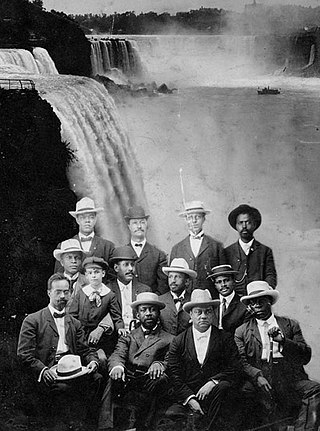
The Niagara Movement (NM) was a civil rights organization founded in 1905 by a group of activists—many of whom were among the vanguard of African-American lawyers in the United States—led by W. E. B. Du Bois and William Monroe Trotter. The Niagara Movement was organized to oppose racial segregation and disenfranchisement. Its members felt "unmanly" the policy of accommodation and conciliation, without voting rights, promoted by Booker T. Washington. It was named for the "mighty current" of change the group wanted to effect and took Niagara Falls as its symbol. The group did not meet in Niagara Falls, New York, but planned its first conference for nearby Buffalo. The Niagara Movement was the immediate predecessor of the NAACP.
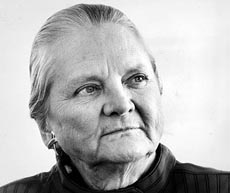
Mary Alexander "Molly" Yard was an American feminist of the late 20th century and social activist who served as National Organization for Women (NOW)'s eighth president from 1987 to 1991 and was a link between first and second-wave feminism.
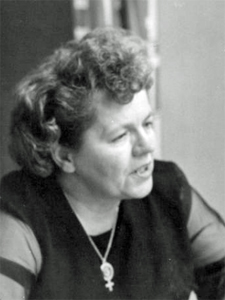
Wilma Louise Scott Heide was an American author, nurse, and social activist. Born in Ferndale, Pennsylvania, Heide trained as a registered nurse in psychiatry at Brooklyn State Hospital. She began her career at a mental hospital in Torrance, Pennsylvania, where she imposed changes to rectify the persistent mistreatment of staff and patients. She received her bachelor's and masters' degrees in sociology from the University of Pittsburgh and was involved in a number of activist groups in the city.

William Mark Peduto is an American politician who was the 60th mayor of Pittsburgh, Pennsylvania from 2014 until 2022. He was a Democratic member of the Pittsburgh City Council from 2002 to 2014.
The NAACP Youth Council is a branch of the NAACP in which youth are actively involved. In past years, council participants organized under the council's name to make major strides in the Civil Rights Movement. Started in 1935 by Juanita E. Jackson, special assistant to Walter White and the first NAACP Youth secretary, the NAACP National Board of Directors formally created the Youth and College Division in March 1936.

Daisy Elizabeth Adams Lampkin was an American suffragist, civil rights activist, organization executive, and community practitioner whose career spanned over half a century. Lampkin’s effective skills as an orator, fundraiser, organizer, and political activist guided the work being conducted by the National Association of Colored Women (NACW); National Association for the Advancement of Colored People (NAACP); National Council of Negro Women and other leading civil rights organizations of the Progressive Era.

The National Association for the Advancement of Colored People (NAACP) is a civil rights organization in the United States, formed in 1909 as an interracial endeavor to advance justice for African Americans by a group including W. E. B. Du Bois, Mary White Ovington, Moorfield Storey, Ida B. Wells, Lillian Wald, and Henry Moskowitz. Over the years, leaders of the organization have included Thurgood Marshall and Roy Wilkins.
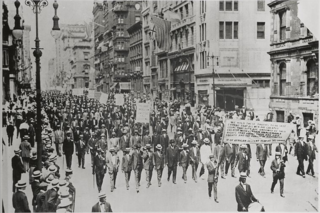
The Negro Silent Protest Parade, commonly known as the Silent Parade, was a silent march of about 10,000 African Americans along Fifth Avenue starting at 57th Street in New York City on July 28, 1917. The event was organized by the NAACP, church, and community leaders to protest violence directed towards African Americans, such as recent lynchings in Waco and Memphis. The parade was precipitated by the East St. Louis riots in May and July 1917 where at least 40 black people were killed by white mobs, in part touched off by a labor dispute where blacks were used for strike breaking.
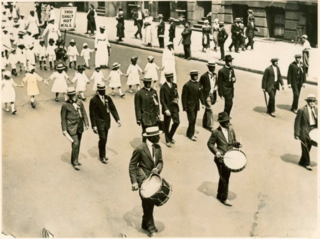
The anti-lynching movement was an organized political movement in the United States that aimed to eradicate the practice of lynching. Lynching was used as a tool to repress African Americans. The anti-lynching movement reached its height between the 1890s and 1930s. The first recorded lynching in the United States was in 1835 in St. Louis, when an accused killer of a deputy sheriff was captured while being taken to jail. The black man named Macintosh was chained to a tree and burned to death. The movement was composed mainly of African Americans who tried to persuade politicians to put an end to the practice, but after the failure of this strategy, they pushed for anti-lynching legislation. African-American women helped in the formation of the movement, and a large part of the movement was composed of women's organizations.
This is a timeline of the civil rights movement in the United States, a nonviolent mid-20th century freedom movement to gain legal equality and the enforcement of constitutional rights for people of color. The goals of the movement included securing equal protection under the law, ending legally institutionalized racial discrimination, and gaining equal access to public facilities, education reform, fair housing, and the ability to vote.
Byrd Rowlett Brown was an American activist, lawyer, and leader in the American Civil Rights Movement. He is best known for improving life for Pittsburgh's African Americans and the poor through his long terms as president of the Pittsburgh Branch of the NAACP and his legal and civil work. He led a march on Duquesne Light to protest unfair hiring practices. This work resulted in the creation of training programs for African-Americans so that they could gain admission into trade unions. He ran for Congress in 1970 and mayor of Pittsburgh in 1989.
The Committee for Freedom Now (CFFN) was an American civil rights organization in Chester, Pennsylvania, that worked to end de facto segregation and improve the conditions at predominantly black schools in Chester. CFFN was founded in 1963 by Stanley Branche along with the Swarthmore College chapter of Students for a Democratic Society and Chester parents. From November 1963 to April 1964, CFFN and the Chester chapter of the NAACP, led by George Raymond, initiated the Chester school protests which made Chester a key battleground in the civil rights movement.
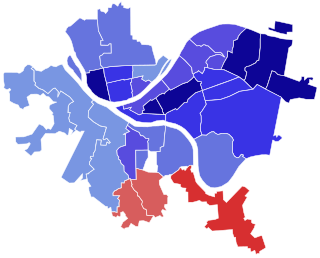
The 2021 Pittsburgh mayoral election took place on November 2, 2021. The primary election was held on May 18, 2021. The Democratic nominee, State Representative Ed Gainey, defeated the Republican nominee, retired police officer Tony Moreno.

The women's suffrage movement in Pennsylvania was an outgrowth of the abolitionist movement in the state. Early women's suffrage advocates in Pennsylvania wanted equal suffrage not only for white women but for all African Americans. The first women's rights convention in the state was organized by Quakers and held in Chester County in 1852. Philadelphia would host the fifth National Women's Rights Convention in 1854. Later years saw suffragists forming a statewide group, the Pennsylvania Woman Suffrage Association (PWSA), and other smaller groups throughout the state. Early efforts moved slowly, but steadily, with suffragists raising awareness and winning endorsements from labor unions.

Eliza Kennedy Smith, also known as Mrs. R. Templeton Smith, was a 20th-century American suffragist, civic activist, and government reformer in Pittsburgh, Pennsylvania. Upon her death in 1964, The Pittsburgh Press described her as "a relentless, tenacious watchdog of the City's purse strings" who "probably attended more budget sessions over the years than anyone else in Pittsburgh either in or out of government".
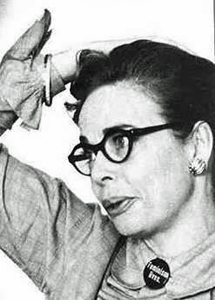
Jo Ann Evansgardner was an American psychologist and social activist. Born in Latrobe, Pennsylvania, she studied psychology at the University of Pittsburgh and met her husband, Gerald Gardner, whom she married the same year she received her bachelor's degree. The couple moved to Dublin, Ireland, but returned to Pittsburgh after five years, where Evansgardner received a doctorate in experimental psychology. She co-founded the Association for Women in Psychology in 1969 and was active alongside her husband in the NAACP and numerous feminist organizations.
Brenda L. Strong Frazier is an American politician and activist. Born in Shelby, North Carolina, Frazier and her family moved to Allegheny County, Pennsylvania, in 1943. She received a bachelor's degree in elementary education at the Indiana University of Pennsylvania and began working as an elementary school teacher in Pittsburgh. She joined the First Pittsburgh chapter of the National Organization for Women (NOW) in 1975 and helped to found the East End chapter of the organization, which required the election of two presidents: one white and one Black. She served as chair of NOW's national minority women's committee.
Dorothy I. "Cindy" Judd Hill was an American feminist and pageant winner. She was working as a music teacher when she was dismissed for being pregnant while on a sabbatical year and sued her school district, alleging that she had faced employment discrimination. Her case went to the Supreme Court of Pennsylvania and was successful, which began her focus on women's rights activism. She was a founding member of the Greater Pittsburgh Area and the South Hills chapters of the National Organization for Women and was actively involved in the campaign to ratify the Equal Rights Amendment. After retiring in 1984, she began to compete in senior beauty pageants and was crowned Ms. National Senior Citizen in 1993.
References
- ↑ Ingram, Sheldon (2022-01-25). "Alma Speed Fox remembered as 'the mother of local Civil Rights Movement' dies at 98". WTAE. Retrieved 2023-05-11.
- 1 2 3 4 5 6 7 8 9 "Alma Speed Fox". In Sisterhood. Retrieved 2022-07-31.
- ↑ Community Leaders and Noteworthy Americans. American Biographical Institute. 1975. p. 295.
- 1 2 Stevens Kane, Kelli (January 28, 2015). "The Chronicle of Alma Speed Fox". Carnegie Museum of Art: Storyboard. Retrieved July 31, 2022.
- ↑ admin. "VFA PIONEER HISTORIES PROJECT: ALMA SPEED FOX". Veteran Feminists of America. Retrieved 2022-07-31.
- 1 2 3 4 5 Conroy, Anthony (January 25, 2022). "Alma Speed Fox, local civil and human rights icon, dies at 98". Pittsburgh Post-Gazette . Archived from the original on July 31, 2022. Retrieved July 31, 2022.
- 1 2 3 "City 'Ms.' Named to Women's Panel". Pittsburgh Post-Gazette . February 8, 1972. p. 5. Retrieved September 17, 2022.
- ↑ Profile of Women at Work in the U.S. Department of the Interior. U.S. Department of the Interior, Office for Equal Opportunity. 1990. p. 66.
- ↑ Bryant, Jean (July 12, 1988). "Woman fights for rights of others". Newspapers.com. Retrieved 2023-08-06.
- ↑ DiVittorio, Michael (January 25, 2022). "Civil rights activist and Pittsburgh resident Alma Speed Fox has died". Pittsburgh Tribune-Review . Retrieved July 31, 2022.
- 1 2 Bob, Bauder (October 23, 2018). "Pittsburgh mayor honors pioneering civil rights activist with key to the city". Pittsburgh Tribune-Review . Retrieved July 31, 2022.
- ↑ Fuoco, Michael A (2009-02-08). "NAACP marks historic first century". Pittsburgh Post-Gazette. pp. , . Retrieved 2023-08-06.
- 1 2 Ruby, Emily (2013). "1968: The Year that Rocked Pittsburgh". Western Pennsylvania History. ISSN 1525-4755.
- 1 2 "MLK riots: 40 years later, turmoil on the Hill stirs memories". Pittsburgh Post-Gazette . April 2, 2008. Retrieved August 30, 2022.
- 1 2 Mellon, Steven; Routh, Julian (April 2, 2018). "The Week the Hill Rose Up". Pittsburgh Post-Gazette . Retrieved July 31, 2022.
- 1 2 3 4 5 Snow, Michael Sean (2004). Dreams Realized and Dreams Deferred: Social Movements and Public Policy in Pittsburgh, 1960–1980 (PDF) (Thesis).
- ↑ "Black Women Here Define Lib Role". The Pittsburgh Press . February 20, 1972. p. 26. Retrieved September 17, 2022.
- ↑ "Distaff Protest". The Pittsburgh Press . April 27, 1975. p. 25. Retrieved September 17, 2022.
- ↑ Shaw, Kurt (January 15, 2009). "Exhibit highlights city's role in equal rights movement". Pittsburgh Tribune-Review . Retrieved June 25, 2022.
- ↑ "Alma Speed Fox, movement's matriarch, inspired city". Pittsburgh Post-Gazette. 2022-02-01. pp. A8. Retrieved 2023-02-22.
- ↑ Crompton, Janice (January 30, 2022). "Obituary: Alma Speed Fox | Fighter against racism, discrimination, injustice in Pittsburgh". Pittsburgh Post-Gazette . Archived from the original on May 5, 2022. Retrieved July 31, 2022.
- ↑ Taylor, Rob (February 2, 2022). "Remembering Alma Speed Fox: 'Mother of the Civil Rights Movement'". New Pittsburgh Courier . Retrieved July 31, 2022.
- ↑ "Local leaders honorarily name street in Hill District after Pittsburgh's 'mother of Civil Rights'". WPXI. 2024-03-23. Retrieved 2024-04-02.